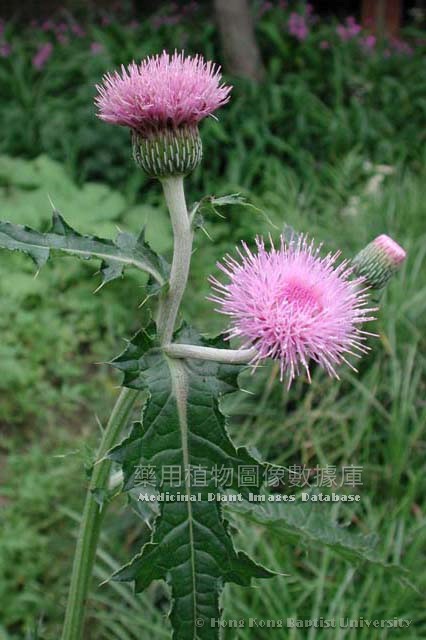|
Cirsium japonicum Fisch. ex DC.

|
English Name |
Japan Thistle, Japanese Thistle, Formosan Thistle, Luoping Thistle, Taiwan Thistle |
|
Latin name |
Cirsium japonicum Fisch. ex DC. |
|
Family & Genus |
Asteraceae, Cirsium |
|
Description |
Perennial herbs. Root tuber up to 7cm in diameter, spindle-shaped or radish-shaped. Stem erect, 30-80cm tall, branches with edges, and long hairs. Blades of basal leaf obovate-elliptic or oblanceolate, with petioles, 8-20cm long, 2.5-8cm wide, pinnate parted or divided, lateral lobes 6-12 pairs, central lateral lobes larger, two ends gradually smaller, margin dentate, tooth end with thorns; leaves gradually smaller upward from base, sessile, base expanded and half amplexicaul, same shaped with basal leaves and equally divided; both of upper and lower sides of stem leaves green, with sparse hairs along the veins. Capitulum, single or several borne at the top of branches, integrated as conical, erect; campanulate involucre, 3cm in diameter; phyllaries arranged as imbricate, about 6 layers, longer toward inner layers, front of outer and middle layer with short spines, oval triangular to long triangular, front of inner layer gradually narrow into soft needle-like, lanceolate or linear-lanceolate; all the flowers bisexual tubular flowers, corolla 5 lobed, purple red or purple, 1.5-2cm long; stamens 5, front of anthers with accessory pieces, base with tails. Achenes, slightly flat, long elliptic, about 4mm long; with dark grey feathery crest, slightly shorter than corolla. Flowering: May to August, fruiting: June to August. |
|
Distribution |
Growing on hill-slopes, grasslands and roadsides. Distributed in Shaanxi, Hebei, Shandong, Jiangsu, Zhejiang, Jiangxi, Fujian, Hubei, Hunan, Taiwan, Guangdong, Guangxi, Sichuan, Guizhou, Yunnan and etc. The medicinal materials are produced in most parts of China. |
|
Part Used |
Medical part: aboveground parts or roots. Chinese name: Daji. |
|
Harvest & Processing |
Excavated roots in the third year of planting, removed earth remnant stem, well washed and sun-dried. cut aboveground parts when flowers fully bloom in summer an autumn, used fresh or sun-dried. |
|
Chemistry |
Fresh leaves contain pectolinarin. Aboveground parts contain β-amyrin acetate, stigmasterol and β-sitosterol, etc. Roots contain volatile oils, such as aplotaxene and dihydroaplotaxene, etc. |
|
Pharmacology |
Hemostatic, decompressing, and anti-bacterial. |
|
Properties & Actions |
Sweet, little cool, cool.Cooling blood and relieving hemorrhage and removing stasis for detumescence. |
|
Indications & Usage |
Hematemesis, empsyxis, non-traumatic hemorrhage, hemafecia, hematuria, metrorrhagia and metrostaxis, hemorrhage due to trauma, anthracia and swelling pain, eczema, hepatitis, nephritis.Oral administration: decocting, 5-10g; fresh products 30-60g. External application: appropriate amount, smashed for application. For hemostasis, better stir-heated with charcoal. |
|
Examples |
1. Epistaxis: Beijing spurge root 1 liang, abri semen 0.5 liang. For the above 2 drugs, coarsely pestle and sieve, take 3 qian each time, decoct in a cup of water and concentrate until reduced to 70%, remove residues, cool down and drink.
2. Treat uterine bleeding, incessant leucorrhea: Beijing spurge 5 qian, tuaiye 3 qian, white coxcomb seed 2 qian, jew's ear 2 qian, stir-fried amoorcorn tree bark 5 qian (such as leucorrhea, but no amoorcorn tree bark). Stew in water and liquor, and drink. |
| Link to |
 Chinese Medicinal Material Images Database Chinese Medicinal Material Images Database
 Chinese Medicine Specimen Database Chinese Medicine Specimen Database
|
|

